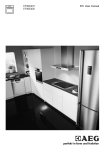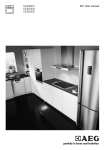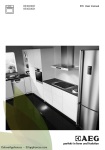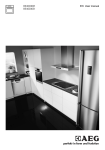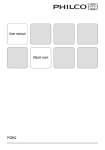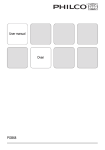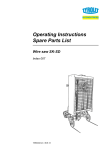Download BP7304001 EN User manual
Transcript
BP7304001 EN User manual 2 www.aeg.com CONTENTS 1. 2. 3. 4. 5. 6. 7. 8. 9. 10. 11. 12. 13. 14. 15. SAFETY INFORMATION . . . . . . . . . . . . . . . . . . . . . . . . . . . . . . . . . . . . . . . . . . . . . . . . . . . . . . 3 SAFETY INSTRUCTIONS . . . . . . . . . . . . . . . . . . . . . . . . . . . . . . . . . . . . . . . . . . . . . . . . . . . . . . 4 PRODUCT DESCRIPTION . . . . . . . . . . . . . . . . . . . . . . . . . . . . . . . . . . . . . . . . . . . . . . . . . . . . . 7 BEFORE FIRST USE . . . . . . . . . . . . . . . . . . . . . . . . . . . . . . . . . . . . . . . . . . . . . . . . . . . . . . . . . . 8 CONTROL PANEL . . . . . . . . . . . . . . . . . . . . . . . . . . . . . . . . . . . . . . . . . . . . . . . . . . . . . . . . . . . 8 DAILY USE . . . . . . . . . . . . . . . . . . . . . . . . . . . . . . . . . . . . . . . . . . . . . . . . . . . . . . . . . . . . . . . . 10 CLOCK FUNCTIONS . . . . . . . . . . . . . . . . . . . . . . . . . . . . . . . . . . . . . . . . . . . . . . . . . . . . . . . . 12 AUTOMATIC PROGRAMMES . . . . . . . . . . . . . . . . . . . . . . . . . . . . . . . . . . . . . . . . . . . . . . . . . 14 USING THE ACCESSORIES . . . . . . . . . . . . . . . . . . . . . . . . . . . . . . . . . . . . . . . . . . . . . . . . . . . 16 ADDITIONAL FUNCTIONS . . . . . . . . . . . . . . . . . . . . . . . . . . . . . . . . . . . . . . . . . . . . . . . . . . . 18 HELPFUL HINTS AND TIPS . . . . . . . . . . . . . . . . . . . . . . . . . . . . . . . . . . . . . . . . . . . . . . . . . . . 20 CARE AND CLEANING . . . . . . . . . . . . . . . . . . . . . . . . . . . . . . . . . . . . . . . . . . . . . . . . . . . . . . 34 WHAT TO DO IF… . . . . . . . . . . . . . . . . . . . . . . . . . . . . . . . . . . . . . . . . . . . . . . . . . . . . . . . . . 37 INSTALLATION . . . . . . . . . . . . . . . . . . . . . . . . . . . . . . . . . . . . . . . . . . . . . . . . . . . . . . . . . . . . 39 GUARANTEE/CUSTOMER SERVICE CENTRES . . . . . . . . . . . . . . . . . . . . . . . . . . . . . . . . . . 41 FOR PERFECT RESULTS Thank you for choosing this AEG product. We have created it to give you impeccable performance for many years, with innovative technologies that help make life simpler – features you might not find on ordinary appliances. Please spend a few minutes reading to get the very best from it. Visit our website for: Get usage advice, brochures, trouble shooter, service information: www.aeg.com Register your product for better service: www.aeg.com/productregistration Buy Accessories, Consumables and Original spare parts for your appliance: www.aeg.com/shop CUSTOMER CARE AND SERVICE We recommend the use of original spare parts. When contacting Service, ensure that you have the following data available. The information can be found on the rating plate. Model, PNC, Serial Number. Warning / Caution-Safety information General information and tips Environmental information Subject to change without notice. ENGLISH 3 1. SAFETY INFORMATION Before the installation and use of the appliance, carefully read the supplied instructions. The manufacturer is not responsible if an incorrect installation and use causes injuries and damages. Always keep the instructions with the appliance for future reference. 1.1 Children and vulnerable people safety WARNING! Risk of suffocation, injury or permanent disability. • This appliance can be used by children aged from 8 years and above and persons with reduced physical, sensory or mental capabilities or lack of experience and knowledge if they are supervised by an adult or a person who is responsible for their safety. • Do not let children play with the appliance. • Keep all packaging away from children. • Keep children and pets away from the appliance when it operates or when it cools down. Accessible parts are hot. • If the appliance has a child safety device, we recommend that you activate it. • Cleaning and user maintenance shall not be made by children without supervision. 1.2 General Safety • Internally the appliance becomes hot when in operation. Do not touch the heating elements that are in the appliance. Always use oven gloves to remove or put in accessories or ovenware. • Do not use a steam cleaner to clean the appliance. • Before maintenance cut the power supply. • Do not use harsh abrasive cleaners or sharp metal scrapers to clean the glass door since they can 4 www.aeg.com scratch the surface, which may result in shattering of the glass. • Excess spillage must be removed before the pyrolytic cleaning. Remove all parts from the oven. • Only use the core temperature sensor recommended for this appliance. • To remove the shelf supports first pull the front of the shelf support and then the rear end away from the side walls. Install the shelf supports in the opposite sequence. 2. SAFETY INSTRUCTIONS 2.1 Installation WARNING! Only a qualified person must install this appliance. • Remove all the packaging. • Do not install or use a damaged appliance. • Obey the installation instruction supplied with the appliance. • Always be careful when you move the appliance because it is heavy. Always wear safety gloves. • Do not pull the appliance by the handle. • Keep the minimum distance from the other appliances and units. • Make sure that the appliance is installed below and adjacent safe structures. • The sides of the appliance must stay adjacent to appliances or to units with the same height. Electrical connection WARNING! Risk of fire and electrical shock. • All electrical connections should be made by a qualified electrician. • The appliance must be earthed. • Make sure that the electrical information on the rating plate agrees with the power supply. If not, contact an electrician. • Always use a correctly installed shockproof socket. • Do not use multi-plug adapters and extension cables. • Make sure not to cause damage to the mains plug and to the mains cable. Contact the Service or an electrician to change a damaged mains cable. • Do not let mains cables to come in touch with the appliance door, specially when the door is hot. • The shock protection of live and insulated parts must be fastened in such a way that it cannot be removed without tools. • Connect the mains plug to the mains socket only at the end of the installation. Make sure that there is access to the mains plug after the installation. • If the mains socket is loose, do not connect the mains plug. • Do not pull the mains cable to disconnect the appliance. Always pull the mains plug. • Use only correct isolation devices: line protecting cut-outs, fuses (screw type fuses removed from the holder), earth leakage trips and contactors. ENGLISH • The electrical installation must have an isolation device which lets you disconnect the appliance from the mains at all poles. The isolation device must have a contact opening width of minimum 3 mm. 2.2 Use WARNING! Risk of injury, burns or electric shock or explosion. • Use this appliance in a household environment. • Do not change the specification of this appliance. • Make sure that the ventilation openings are not blocked. • Do not let the appliance stay unattended during operation. • Deactivate the appliance after each use. • Be careful, when you open the appliance door while the appliance is in operation. Hot air can release. • Do not operate the appliance with wet hands or when it has contact with water. • Do not apply pressure on the open door. • Do not use the appliance as a work surface or as a storage surface. • Always keep the appliance door closed when the appliance is in operation. • Open the appliance door carefully. The use of ingredients with alcohol can cause a mixture of alcohol and air. • Do not let sparks or open flames to come in contact with the appliance when you open the door. • Do not put flammable products or items that are wet with flammable products in, near or on the appliance. WARNING! Risk of damage to the appliance. • To prevent damage or discoloration to the enamel: – do not put ovenware or other objects in the appliance directly on the bottom. 5 – do not put aluminium foil directly on the bottom of the appliance. – do not put water directly into the hot appliance. – do not keep moist dishes and food in the appliance after you finish the cooking. – be careful when you remove or install the accessories. • Discoloration of the enamel has no effect on the performance of the appliance. It is not a defect in the sense of the warranty law. • Use a deep pan for moist cakes. Fruit juices cause stains that can be permanent. 2.3 Care and Cleaning WARNING! Risk of injury, fire or damage to the appliance. • Before maintenance, deactivate the appliance and disconnect the mains plug from the mains socket. • Make sure the appliance is cold. There is the risk that the glass panels can break. • Replace immediately the door glass panels when they are damaged. Contact the Service. • Be careful when you remove the door from the appliance. The door is heavy! • Clean regularly the appliance to prevent the deterioration of the surface material. • Remaining fat or food in the appliance can cause fire. • Clean the appliance with a moist soft cloth. Only use neutral detergents. Do not use abrasive products, abrasive cleaning pads, solvents or metal objects. • If you use an oven spray, obey the safety instructions on the packaging. • Do not clean the catalytic enamel (if applicable) with any kind of detergent. Pyrolytic cleaning WARNING! Risk of fire and burns. 6 www.aeg.com • Before carrying out a Pyrolitic selfcleaning function or the First Use function please remove from the oven cavity: – Any excess food residues, oil or grease spills / deposits. – Any removable objects (including shelves, side rails etc., provided with the product) particularly any nonstick pots, pans, trays, utensils etc. • Read carefully all the instructions for Pyrolytic cleaning. • Keep children away from the appliance while the Pyrolytic cleaning is in operation. The appliance becomes very hot. • Pyrolitic cleaning is a high temperature operation that can release fumes from cooking residues and construction materials, as such consumers are strongly advised to: – Provide good ventilation during and after each Pyrolytic cleaning. – Provide good ventilation during and after the first use at maximum temperature operation. – Remove any pets (especially birds) from the vicinity of the appliance location during and after the Pyrolytic cleaning and first use maximum temperature operation to a well ventilated area. • Unlike all humans, some birds and reptiles can be extremely sensitive to potential fumes emitted during the cleaning process of all Pyrolytic Ovens. • Small pets can also be highly sensitive to the localized temperature changes in the vicinity of all Pyrolytic Ovens when the Pyrolytic self cleaning program is in operation. • Non-stick surfaces on pots, pans, trays, utensils etc., can be damaged by the high temperature Pyrolytic cleaning operation of all Pyrolytic Ovens and can be also a source for low level harmful fumes. • Fumes released from all Pyrolytic Ovens / Cooking Residues as described are not harmful to humans, including infants or persons with medical conditions. 2.4 Internal light • The type of light bulb or halogen lamp used for this appliance, is only for household appliances. Do not use it for house lighting. WARNING! Risk of electrical shock. • Before replacing the lamp, disconnect the appliance from the power supply. • Only use lamps with the same specifications. 2.5 Disposal WARNING! Risk of injury or suffocation. • Disconnect the appliance from the mains supply. • Cut off the mains cable and discard it. • Remove the door catch to prevent children and pets to get closed in the appliance. ENGLISH 7 3. PRODUCT DESCRIPTION 1 1 Control panel 2 2 Electronic programmer 3 4 5 5 4 10 3 Socket for the core temperature sen- sor 4 Heating element 5 Lamp 6 Fan 3 2 1 9 6 7 Rear wall heating element 7 8 8 Bottom heat 9 Shelf support, removable 10 Shelf positions 3.1 Accessories Wire shelf For cookware, cake tins, roasts. Baking tray For cakes and biscuits. Grill- / Roasting pan To bake and roast or as a pan to collect fat. Core temperature sensor To measure how far the food is cooked. 8 www.aeg.com 4. BEFORE FIRST USE WARNING! Refer to the Safety chapters. After the software version goes off, the display shows h and 12:00. Setting the time of day: 4.1 Initial Cleaning • Remove all parts from the appliance. • Clean the appliance before first use. 1. Touch or to set the hours. 2. Touch or . 3. Touch or to set the minutes. 4. Refer to chapter "Care and Cleaning". Touch or . The Temperature / Time display shows the new time. 4.2 Setting and changing the time After the first connection to the mains, all symbols in the display are on for some seconds. For the subsequent few seconds the display shows the software version. Changing the time of day You can change the time of day only . when the appliance is off. Touch flashes in the display. To set the new time of day, use the above procedure. 5. CONTROL PANEL 5.1 Electronic programmer 1 2 3 4 5 6 7 8 9 10 Use the sensor fields to operate the appliance. Sensor Field Function Description - DISPLAY Shows the current settings of the appliance. 2 ON / OFF To activate and deactivate the appliance. 3 OPTIONS To set an oven function, an automatic programme or a cleaning function (selected models only). Straight access to an oven function when the appliance is off. 1 ENGLISH Sensor Field Function 9 Description 4 MY FAVOURITE PROGRAMME To store your favourite programme. Use it to have access to your favourite programme directly or when the appliance is deactivated. 5 TEMPERATURE / FAST HEAT UP To set and see the cavity temperature or the core temperature sensor temperature (if present). If you press and hold it for three seconds, it turns the Fast heat up function ON or OFF. Straight access to the temperature setting of the first oven function when the appliance is off. 6 UP, DOWN 7 OK 8 OVEN LIGHT 9 CLOCK To set the clock functions. 10 MINUTE MINDER To set the Minute Minder. To move up or down in the menu. To confirm a selection or setting. To move down in the menu. To activate or deactivate the oven lamp. 5.2 Display 1 2 A) Oven function symbol B) Temperature / Time display C) Clock / Residual heat display (also 3 Minute minder and Time of day) 7 6 5 4 D) Residual heat indicator E) Indicators for the clock functions (re- fer to the table "Clock functions") F) Heat up indicator G) Number of oven function/pro- gramme 5.3 Other indicators in the display Symbols Name Description Functions You can choose an oven function. Automatic programme You can choose an oven programme. 10 www.aeg.com Symbols / / Name Description My favourite programme The favourite programme operates. kgr / gr An oven programme with a weight input operates. h / min A clock function operates. Temperature / Fast heat up The function operates. Temperature You can see or change the temperature. Core temperature sensor The core temperature sensor is in the core temperature sensor socket. Door lock The door lock function operates. Oven light The light is off. Minute minder The minute minder function operates. 5.4 Heat up indicator If you activate an oven function, the bars come on in the display. The bars show that the temperature in the appliance increases or decreases. When the appliance is at the set temperature, the bars go off the display. 6. DAILY USE WARNING! Refer to the Safety chapters. To operate the appliance you can use: • The manual mode - to set a heating function, the temperature and the cooking time manually. Oven function • automatic programmes - to prepare a dish when you do not have knowledge or experience in cooking. Application 1 True Fan Cooking To bake on maximum on 3 shelf positions at the same time and to dry food. Set the temperature 68 - 104 °F lower than for Conventional Cooking. 2 Pizza Setting To bake food on 1 shelf position for a more intensive browning and a crispy bottom. Set the temperature 68 - 104 °F lower than for Conventional Cooking. 3 Slow Cook To prepare very lean and tender roasted food. 4 Conventional Cooking To bake and roast food on 1 shelf position. ENGLISH Oven function 11 Application 5 Frozen Foods 6 Turbo Grilling To roast larger meat joints or poultry with bones on 1 shelf position. Also to gratinate and to brown. 7 Fast Grilling 8 Grilling 9 To make convenience food such as chips, wedges or spring rolls crispy. To grill flat food in large quantities and to toast bread. To grill flat food and to toast. Moist Fan Bak- To save energy when you bake and cook dry ing baked goods. Also to bake baked goods in tins on 1 shelf position. 10 Keep Warm To keep food warm. 11 Defrost 12 Bottom Heat 13 ECO Roasting ECO functions let you optimize the energy consumption during cooking. Thus, it is necessary to set the cooking time first. To get more information about the recommended settings, refer to the cooking tables for an oven function that is almost the same. 14 Pyro Cleaning For automatic pyrolytic cleaning of the oven. The oven temperature is at approximately 932 °F. It burns off residual dirt in the oven. This can then be removed with a cloth when the oven is cold. To defrost frozen food. To bake cakes with a crispy bottom and to preserve food. 6.1 Setting the oven function 6.2 Changing the temperature 1. Activate the appliance with or . The display shows the set temperature, the symbol and the number of the oven function. 2. Touch tion. Touch / to change the temperature in steps of 41 °F. When the appliance is at the set temperature, an acoustic signal sounds three times and the Heat up indicator goes out. 3. Touch or the appliance starts automatically after five seconds. or to set an oven func- If you activate the appliance and do not set an oven function or programme, the appliance deactivates automatically after 20 seconds. 6.3 Checking the temperature You can see the temperature in the appliance when the function or programme operates. 1. Touch . The Temperature / Time display shows the temperature in the appliance. If you want to change the 12 www.aeg.com oven temperature, touch more time and use or 2. one . Touch to go back to the set temperature or the display shows it automatically after five seconds. 6.4 Fast heat up function The Fast heat up function decreases the heat up time. Activating the Fast heat up function: for more than three Touch and hold seconds. If you activate the Fast heat up function, flash one by the bars on the display one and comes on to show that the function operates. Additional information: • Do not put food into the oven when the Fast heat up function operates. • The Fast heat up is not available with all oven functions. An acoustic signal sounds if the Fast heat up is not available for the set function. 6.5 Energy saving The appliance contains features which help you save energy during everyday cooking: • Residual heat: – When the heating function or programme operates, the heating elements are deactivated 10% earlier (the lamp and fan continue to operate). For this feature to operate, the cooking time must be longer than 30 minutes or you must use the clock functions (Duration, End, Time delay). This feature does not operate with the grill functions. – When the appliance is off, you can use the heat to keep food warm. The clock / residual heat display shows the remaining temperature, and the bars show the temperature as it decreases. • Cooking with the lamp off to deactivate the Touch lamp during cooking. • Deactivating the display - If necessary, you can fully deactivate the appliance. Touch and at the same time until the display goes out. This step also activates the appliance. • Eco functions - refer to "Oven functions". 7. CLOCK FUNCTIONS SYMBOL FUNCTION DESCRIPTION COUNT UP TIMER To set count up. It shows how long the appliance operates. This function has no effect on the operation of the appliance. TIME OF DAY To examine the time of day. For changing the time of day refer to 'Setting the time of day'. DURATION To set how long the appliance operates. END To set when the appliance deactivates. You can use Duration and End at the same time (Time delay), if the appliance is to be activate and deactivate automatically later. ENGLISH SYMBOL FUNCTION DESCRIPTION SET+GO To start the appliance with necessary settings with only one touch of the sensor field, any time later. 7.1 Count Up Timer Use the Count Up Timer to monitor how long the appliance operates. It is on immediately when the appliance starts to heat. . Reset the Count Up Timer: touch Touch until the display shows "00:00" and the Count Up Timer starts to count up again. You cannot use the Count Up Timer when Duration or End is set. 7.2 Setting the DURATION 1. Activate the appliance and set an oven function and temperature. 2. Touch again and again until the display shows . flashes in the display. 3. Use or DURATION. 4. Touch 5. Use or DURATION. to set the minutes for to confirm. to set the hours for If you touch or while you set the DURATION, the appliance switches to the setting of the END function. 6. When the set time ends, an acoustic signal sounds for two minutes. and time setting flash in the display. The appliance deactivates. Touch a sensor field or open the oven door to stop the acoustic signal. 7. Deactivate the appliance. 7.3 Setting the END 1. 13 Activate the appliance and set an oven function and temperature. 2. Touch again and again until the display shows . flashes in the display. 3. Use or to set the END (first you set the minutes and then the hours) and or to confirm. 4. When the set time ends, an acoustic signal sounds for two minutes. symbol and the time setting flash in the display. The appliance deactivates. 5. Touch a sensor field or open the oven door to stop the acoustic signal. 6. Deactivate the appliance. 7.4 Check result (selected models only) If you set the END or DURATION function, two minutes before the end of cooking an acoustic signal sounds and the lamp activates. The appliance goes to the setting of the END or DURATION function. During these two minutes you can examine the results of the cooking, and, if necessary, add the END or DURATION time. 7.5 Setting the SET+GO 1. Set an oven function (or programme) and temperature (refer to "Setting the oven function" and "Changing the temperature"). 2. Set the DURATION (refer to "Setting the DURATION"). 3. Touch again and again until flashes in the display. 4. Touch tion. to set the SET+GO func- and with an The display shows indicator. This indicator shows which clock function is activated. 14 www.aeg.com 5. Touch a sensor field (apart from ON / OFF) to start the SET+GO function. You can use the SET+GO function only when the DURATION is set. 4. When the set time ends, an acoustic signal sounds for two minutes and 00:00 and flash in the display. 5. Touch a sensor field or open the oven door to stop the acoustic signal. 7.6 Setting the MINUTE MINDER 7.7 Setting the Time delay function Use the MINUTE MINDER to set a countdown (maximum 2 h 30 min). This function has no effect on the operation of the oven. You can set the MINUTE MINDER at any time and also when the appliance is off. The DURATION and END functions can be used at the same time, if the oven is to be activated and deactivated automatically later. In this case, first and then the END set the DURATION function (refer to "Setting the DURATION" and "Setting the END" ). When the Time delay function is activated, the display shows a static symbol of with a dot and . the oven function, The dot shows which clock function is on in the Clock / residual heat display. 1. Touch display. 2. Use or to set the MINUTE MINDER. First you set the seconds, then the minutes and the hours. 3. Touch or the MINUTE MINDER starts automatically after five seconds. . and "00" flash in the 8. AUTOMATIC PROGRAMMES WARNING! Refer to the Safety chapters. 8.1 RECIPE MENU The display shows the shelf position and the default cooking times for all automatic recipes. There are three types of automatic programmes: • Automatic recipes • Automatic programmes with weight input • Automatic programmes with the core temperature sensor There are 20 automatic programmes and recipes. Use an automatic programme or recipe when you do not have the knowledge or experience on how to prepare a dish. You can find the list of the recipes for the automatic programmes in the "Recipe book". 8.2 Automatic programmes Programme number Programme name 1 BRAISED MEAT 2 ROAST PORK ENGLISH Programme number Programme name 3 ROAST VEAL 4 ROAST LAMB 5 ROAST GAME 6 CHICKEN, WHOLE 7 WHOLE FISH 8 PIZZA 9 QUICHE LORRAINE 10 LEMON SPONGE CAKE 11 CHEESE CAKE 12 ROLLS 13 FARMER BREAD 14 DOUGH PROVING 15 POTATO GRATIN 16 LASAGNE 17 CANNELLONI 18 CONVENIENCE CAKE 19 CONVENIENCE PIZZA 20 CONVENIENCE POTATO TYPES You can find the recipes for the automatic programmes specified for this appliance on our website. To find the proper Recipe Book check the PNC number on the rating plate on the front frame of the appliance cavity. 8.3 Automatic recipes Setting an automatic recipe: 1. Activate the appliance. 2. Touch . The display shows ,a symbol and the number of the automatic programme. 3. Touch or matic recipe. 6. Touch a sensor field or open the appliance door to stop the acoustic signal. 8.4 Automatic programmes with weight input If you set the weight of the meat, the appliance calculates the roasting time. 1. Activate the appliance. 2. Touch 3. Touch or to set the weight programme (refer to the "Recipe book"). The display shows: the cooking time, the duration symbol , a default weight, a unit of measurement (kg, g). to choose the auto- 4. Touch or the automatic recipe activates automatically after five seconds. 5. When the set time ends, an acoustic signal sounds for two minutes. flashes. The appliance deactivates. 15 4. . Touch or the settings save automatically after five seconds. 5. The appliance activates. A symbol of the weight unit flashes in the display. During this time you can change the or . default weight value with Touch . 16 www.aeg.com 6. When the set time ends, an acoustic signal sounds for two minutes. flashes. The appliance deactivates. 7. Touch a sensor field or open the door to stop the acoustic signal. 8.5 Automatic programmes with the core temperature sensor The core temperature of the food is default and fixed in programmes which use the core temperature sensor. The programme ends when the appliance is at the set core temperature. 1. Activate the appliance. 2. Touch again and again until the display shows . 3. Install the core temperature sensor (refer to "The core temperature sensor"). 4. Touch or to see the core temperature sensor programmes. When a core temperature sensor programme is set, the display shows and . the cooking time, 5. Touch or the settings save automatically after five seconds. 6. When the set time ends, an acoustic signal sounds for two minutes. flashes. The appliance deactivates. 7. Touch a sensor field or open the oven door to stop the acoustic signal. 9. USING THE ACCESSORIES WARNING! Refer to the Safety chapters. 2. 9.1 The core temperature sensor The core temperature sensor measures the core temperature of the meat. When the meat is at the set temperature, the appliance deactivates. There are two temperatures to set: • The oven temperature: refer to the table for roasting in the recipe book. • The core temperature: refer to the table for the core temperature sensor in the recipe book. Only use the core temperature sensor supplied or original replacement parts. 1. Activate the appliance. Put the point of the core temperature sensor (with the symbol on the handle) into the centre of the meat. 3. Put the plug of the core temperature sensor into the socket at the front of the appliance. The display shows a flashing symbol and the default set core temperature. The temperature is 140 °F during the first use, and the last set value during each subsequent use. 4. Touch or perature. to set the core tem- ENGLISH 5. Touch or the settings save automatically after 5 seconds. You can set the core temperature only when the symbol flashes. If the display shows a static symbol before you set the core temperature, use and or to set a new value. 6. Set the oven function and, if necessary, the oven temperature. The display shows the current core temperature and (which shows the relation between the set oven temperature and the current oven temperature). Touch a sensor field to deactivate the acoustic signal. 8. Remove the core temperature sensor from the socket and remove the meat from the appliance. WARNING! Be careful when you remove the core temperature sensor. It is hot. There is a risk of burns. 9. Deactivate the appliance. When you put the core temperature sensor into the socket, you cancel the settings for the clock functions. When you cook with the core temperature sensor, you can change the temperature shown in the Temperature/Time display. After you put the core temperature sensor in the socket and set an oven function and temperature, the display shows the current core temperature. The core temperature sensor must stay in the meat and in the socket during the cooking. While the appliance calculates the approximate duration time, the value of the Count Up Timer function shows in the Timer/Residual heat display. When the first calculation ends, the Timer/ Residual heat display shows -, and then the approximate duration of the cooking. The appliance continues to calculate the duration during the cooking. The display updates at intervals with the new duration value. 7. When the meat is at the set core temperature, the core temperature and flash. An acoustic signal sounds for two minutes. 17 again and again to Touch see three other temperatures: • The current core temperature • The oven set temperature • The current oven temperature. The set core temperature changes into current core temperature and current oven temperature changes into set oven temperature. 9.2 Inserting the oven accessories The deep pan and the wire shelf have side edges. These edges and the shape of the guide-bars are a special device to prevent the cookware from slipping. 18 www.aeg.com Installing the wire shelf and the deep pan together Put the wire shelf on the deep pan. Push the deep pan between the guide-bars of one of the oven levels. 10. ADDITIONAL FUNCTIONS 10.1 My Favourite Programme function Use this function to save your favourite temperature and time settings for an oven function or programme. 1. Set the temperature and time for an oven function or programme. 2. Touch and hold and at the same time for 2 seconds. An acoustic signal sounds. SAFE comes on or goes out in the display. If the appliance has the Pyrolytic cleaning function and the function operates, the door is locked. A message comes on in the display when you touch a sensor field. 2. Touch and hold for more than three seconds. An acoustic signal sounds. 3. Deactivate the appliance. Using My Favourite Programme function: • To activate the function touch . The appliance activates your favourite programme. • To deactivate the function touch . The appliance deactivates your favourite programme. When the function operates, you can change the time and temperature. 10.2 Child Lock The Child Lock prevents an accidental operation of the appliance. Activating and deactivating the Child Lock function: 1. Deactivate the appliance with Do not set an oven function. . 10.3 Function Lock You can activate the function only when the appliance operates. The Function Lock prevents an accidental change of the oven function. Activating / deactivating the Function Lock function: 1. Activate the appliance. 2. Activate an oven function or setting. 3. Touch and hold and at the same time for 2 seconds. An acoustic signal sounds. Loc comes on or goes out in the display. Useful information: You can deactivate the appliance when the Function Lock is on. When you deactivate the appliance, the Function Lock deactivates. If the appliance has the Pyrolytic cleaning function and the function operates, the door is locked. A message comes on ENGLISH in the display when you touch a sensor field. 10.4 Settings menu The settings menu lets you to add or remove functions from the main menu (for 19 example: you can set on or off the Residual heat indicator). Settings menu has maximum eight settings (from SET1 to SET8). The number of the settings is different for different models. Look into the table below to see the possible value of each setting. Settings menu Indicator of the setting menu Description Value to set SET1 SET+GO ON / OFF SET2 RESIDUAL HEAT INDICATOR ON / OFF SET3 CLEANING REMINDER ON / OFF SET41) KEY TONE CLICK / BEEP / OFF SET5 FAULTY TONE ON / OFF SET6 SERVICE MENU --- SET7 RESTORE SETTINGS YES / NO SET82) TIME EXTENSION ON / OFF 1) It is not possible to deactivate the tone of the ON / OFF sensor field. 2) Selected models only You can set the settings menu only when the appliance is off. Activate the Settings menu: 1. If necessary, deactivate the appliance . 2. Touch and hold for three seconds. The display shows "SET1" and "1" flashes. 3. Touch / 4. Touch . to set the setting. 5. Touch / to change the value of the setting. 6. Touch . 10.5 Automatic switch-off For safety reasons the appliance deactivates automatically after some time: • if an oven function operates. • if you do not change the oven temperature. Oven temperature Switch-off time 80 °F - 245 °F 12.5 h 250 °F - 395 °F 8.5 h 400 °F - 480 °F 5.5 h 485 °F - maximum °F 3.0 h After an automatic switch-off, touch a sensor field to operate the appliance again. The Automatic switch-off works with all oven functions, apart from Light, Slow Cook, Core Temperature Sensor, Duration, End, Time delay. 20 www.aeg.com 10.6 Brightness of the display There are two modes of display brightness: • Night brightness - when the appliance is deactivated, the brightness of the display is lower between 10 PM and 6 AM. • Day brightness: – When the appliance is activated. – If you touch a sensor field during the night brightness (apart from ON / OFF), the display goes back to the day brightness mode for the next 10 seconds. – If the appliance is deactivated and you set the Minute Minder. When the Minute Minder function ends, the display goes back to the night brightness. 10.7 Cooling fan When the appliance operates, the cooling fan activates automatically to keep the surfaces of the appliance cool. If you deactivate the appliance, the cooling fan can continue to operate until the appliance cools down. 11. HELPFUL HINTS AND TIPS 11.1 Inner side of the door In some models, on the inner side of the door you can find: • The numbers of the shelf positions. • Information about the heating functions, recommended shelf positions and temperatures for typical dishes. The temperature and baking times in the tables are guidelines only. They depend on the recipes and the quality and quantity of the ingredients used. 11.2 Baking General instructions • Your new oven can bake or roast differently to the appliance you had before. Adapt your usual settings (temperature, cooking times) and shelf positions to the values in the tables. • With longer baking times, you can deactivate the oven approximately 10 mi- nutes before the end of the baking time and then use the residual heat. When you cook frozen food, the trays in the oven can twist during baking. When the trays become cold again, the distortions are gone. How to use the Baking Tables • The manufacturer recommends that you use the lower temperature the first time. • If you cannot find the settings for a special recipe, look for the one that is almost the same. • You can extend baking times by 10 – 15 minutes if you bake cakes on more than one level. • Cakes and pastries at different heights do not always brown equally at first. If this occurs, do not change the temperature setting. The differences equalize during the baking procedure. 11.3 Tips on baking Baking results The bottom of the cake is not browned sufficiently. Possible cause Remedy The shelf position is incorrect. Put the cake on a lower shelf. ENGLISH Baking results 21 Possible cause Remedy The cake sinks and becomes soggy, lumpy or streaky. The oven temperature is too high. The next time you bake, set a slightly lower oven temperature. The cake sinks and becomes soggy, lumpy or streaky. The baking time is too short. Set a longer baking time. You cannot decrease baking times by setting higher temperatures. The cake sinks and becomes soggy, lumpy or streaky. There is too much liquid in the mixture. Use less liquid. Be careful with mixing times, especially if you use a mixing machine. The cake is too dry. The oven temperature is too low. The next time you bake, set a higher oven temperature. The cake is too dry. The baking time is too long. The next time you bake, set a shorter baking time. The cake browns unevenly. The oven temperature is Set a lower oven tempertoo high and the baking ature and a longer baktime is too short. ing time. The cake browns unevenly. The mixture is unevenly distributed. Spread the mixture evenly on the baking tray. The cake is not ready in the baking time given. The oven temperature is too low. The next time you bake, set a slightly higher oven temperature. 11.4 Baking on one level: Baking in tins Type of baking Oven function Shelf position Temperature °F Time in min. Ring cake or brioche True Fan Cooking 1 300 - 320 50 - 70 Madeira cake / fruit cakes True Fan Cooking 1 280 - 320 70 - 90 Fatless sponge cake / Fatless sponge cake True Fan Cooking 2 280 - 300 35 - 50 Fatless sponge cake / Fatless sponge cake Conventional Cooking 2 320 35 - 50 22 www.aeg.com Type of baking Oven function Shelf position Temperature °F Time in min. Flan base short pastry True Fan Cooking 2 340 - 360 1) 10 - 25 Flan base sponge mixture True Fan Cooking 2 300 - 340 20 - 25 Apple pie / Apple pie (2tins Ø20cm, diagonally off set) True Fan Cooking 2 320 60 - 90 Apple pie / Apple pie (2tins Ø20cm, diagonally off set) Conventional Cooking 1 360 70 - 90 Cheesecake Conventional Cooking 1 340 - 380 60 - 90 1) Preheat the oven Cakes / pastries / breads on baking trays Type of baking Oven function Shelf position Temperature °F Time in min. Plaited bread / bread crown Conventional Cooking 3 340 - 380 30 - 40 Christmas stollen Conventional Cooking 2 320 - 360 1) 50 - 70 Bread (rye bread): 1. First part of baking process. 2. Second part of baking process. Conventional Cooking 1 Cream puffs / eclairs Conventional Cooking 3 380 - 410 1) 20 - 35 Swiss roll Conventional Cooking 3 360 - 4001) 10 - 20 True Fan Cooking 3 300 - 320 20 - 40 Cake with crumble topping (dry) 1. 2. 4501) 320 - 360 1. 2. 20 30 - 60 ENGLISH Type of baking 23 Oven function Shelf position Temperature °F Time in min. Buttered almond cake / sugar cakes Conventional Cooking 3 380 - 410 1) 20 - 30 Fruit flans (made with yeast dough / sponge mixture) 2) True Fan Cooking 3 300 35 - 55 Fruit flans (made with yeast dough / sponge mixture) 2) Conventional Cooking 3 340 35 - 55 True Fan Cooking 3 320 - 340 40 - 80 Conventional Cooking 3 320 - 360 1) 40 - 80 Oven function Shelf position Temperature °F Time in min. Short pastry biscuits True Fan Cooking 3 300 - 320 10 - 20 Short bread / Short bread / Pastry Stripes True Fan Cooking 3 280 20 - 35 Short bread / Short bread / Pastry Stripes Conventional Cooking 3 320 1) 20 - 30 Biscuits made with sponge mixture True Fan Cooking 3 300 - 320 15 - 20 Pastries made with egg white, merungues True Fan Cooking 3 180 - 210 120 - 150 Macaroons True Fan Cooking 3 210 - 250 30 - 50 Fruit flans made with short pastry Yeast cakes with delicate toppings (e.g, quark, cream, custard) 1) Preheat the oven 2) Use deep pan Biscuits Type of baking 24 www.aeg.com Type of baking Oven function Shelf position Temperature °F Time in min. Biscuits made with yeast dough True Fan Cooking 3 300 - 320 20 - 40 Puff pastries True Fan Cooking 3 340 - 3601) 20 - 30 Rolls True Fan Cooking 3 3201) 10 - 25 Rolls Conventional Cooking 3 380 - 4101) 10 - 25 Small cakes / Small cakes (20 per tray) True Fan Cooking 3 3001) 20 - 35 Small cakes / Small cakes (20 per tray) Conventional Cooking 3 3401) 20 - 30 Oven function Shelf position Temperature °F Time in min. Pasta bake Conventional Cooking 1 360 - 400 45 - 60 Lasagne Conventional Cooking 1 360 - 400 25 - 40 Vegetables au Turbo Grilling or True Fan gratin 1) Cooking 1 320 - 340 15 - 30 Baguettes topped with melted cheese Turbo Grilling or True Fan Cooking 1 320 - 340 15 - 30 Sweet bakes Conventional Cooking 1 360 - 400 40 - 60 Fish bakes Conventional Cooking 1 360 - 400 30 - 60 Stuffed vegetables Turbo Grilling or True Fan Cooking 1 320 - 340 30 - 60 1) Preheat the oven Bakes and gratins Dish 1) Preheat the oven ENGLISH 25 Moist Fan Baking Type of food Shelf position Temperature (°F) Time (min.) Pasta bake 2 360 - 400 45 - 60 Lasagne 2 360 - 400 45 - 60 Potato gratin 2 380 - 410 55 - 80 Sweet dishes 2 360 - 400 45 - 60 Ring cake or brioche 1 320 - 340 50 - 70 Plaited bread / bread crown 2 340 - 380 40 - 50 Cake with crumble topping (dry) 3 320 - 340 20 - 40 Biscuits made with yeast dough 2 320 - 340 20 - 40 11.5 Multileveled Baking Cakes / pastries / breads on baking trays True Fan Cooking Type of baking Shelf position Temperature in °F Time in min. 2 levels 3 levels Cream puffs / Eclairs 1/4 - 320 - 360 1) 25 - 45 Dry streusel cake 1/4 - 300 - 320 30 - 45 1) Preheat the oven Biscuits / small cakes / small cakes / pastries / rolls True Fan Cooking Type of baking Shelf position Temperature in °F Time in min. 2 levels 3 levels Short pastry biscuits 1/4 1 /3 / 5 300 - 320 20 - 40 Short bread / Short bread / Pastry Stripes 1/4 1/3/5 280 25 - 50 Biscuits made with sponge mixture 1/4 - 320 - 340 25 - 40 26 www.aeg.com True Fan Cooking Type of baking Shelf position Temperature in °F Time in min. 2 levels 3 levels Biscuits made with egg white, meringues 1/4 - 180 - 210 130 - 170 Macaroons 1/4 - 210 - 250 40 - 80 Biscuits made with yeast dough 1/4 - 320 - 340 30 - 60 Puff pastries 1/4 - 340 - 360 1) 30 - 50 Rolls 1/4 - 360 30 - 55 Small cakes / Small cakes (20 per tray) 1/4 - 3001) 25 - 40 1) Preheat the oven When you use this function, always cook dishes without a cover. 11.6 Slow Cook Use this function to prepare lean, tender pieces of meat and fish with core temperatures no more than 150 °F. Slow Cook is not applicable to such recipes as pot roast or fatty roast pork. You can use the Core Temperature Sensor to guarantee that the meat has the correct core temperature (see table for the Core Temperature Sensor). In the first 10 minutes you can set an oven temperature between 180 °F and 300 °F. The default is 195 °F. After the temperature is set, the oven continues to cook at 180 °F. Do not use the automatic slow cook function for poultry. Food to be cooked Sear the meat in a pan on the hob on a very high setting for 1 - 2 minutes on each side. 2. Put the meat together with the hot roasting pan into the oven on the wire shelf. 3. Put the Core Temperature Sensor into the meat. 4. Select the Slow cook function and set the correct end core temperature. 1. Weight (g) Shelf position Temperature °F Time in min. Roast beef 1000 - 1500 1 250 120 - 150 Fillet of beef 1000 - 1500 3 250 90 - 150 Roast veal 1000 - 1500 1 250 120 - 150 200 - 300 3 250 20 - 40 Shelf position Temperature °F Time Min. 2 400 - 450 1)2) 15 - 20 Steaks 11.7 Pizza Setting Type of baking Pizza (thin crust) ENGLISH Type of baking Shelf position Temperature °F Time Min. Pizza (with a lot of topping) 2 360 - 400 20 - 30 Tarts 1 360 - 400 40 - 55 Spinach flan 1 320 - 360 45 - 60 Quiche Lorraine 1 340 - 380 45 - 55 Swiss flan 1 340 - 380 45 - 55 Apple cake, covered 1 300 - 340 50 - 60 Vegetable pie 1 320 - 360 50 - 60 Unleavened bread 2 450 - 4801) 10 - 20 Puff pastry flan 2 320 - 360 1) 45 - 55 Flammekuchen (Pizza-like dish from Alsace) 2 450 - 4801) 12 - 20 Piroggen (Russian version of calzone) 2 360 - 400 1) 15 - 25 27 1) Preheat the oven 2) Use deep pan 11.8 Roasting • Use heat-resistant ovenware to roast (refer to the instructions of the manufacturer). • You can roast large roasting joints directly in the deep pan (if present) or on the wire shelf above the deep pan. • Roast lean meats in the roasting tin with the lid. This keeps the meat more succulent. • All types of meat that can be browned or have crackling can be roasted in the roasting tin without the lid. • We recommend that you cook meat and fish weighing 1 kg and above in the oven. • To prevent the meat juices or fat from burning onto the pan, put some liquid into the deep pan. • If necessary, turn the roast (after 1 / 2 2 / 3 of the cooking time). • Baste large roasts and poultry with their juices several times during roasting. This gives better roasting results. • You can deactivate the appliance approximately 10 minutes before the end of the roasting time, and use the residual heat. 11.9 Roasting with Turbo Grilling Beef Type of meat Quantity Oven function Shelf position Temperature °F Time min. Pot roast 1 - 1.5 kg Conventional Cooking 1 450 120 - 150 28 www.aeg.com Type of meat Quantity Oven function Shelf position Temperature °F Time min. Roast beef or fillet: rare per cm. of thickness Turbo Grilling 1 380 - 4001) 5-6 Roast beef or fillet: medium per cm. of thickness Turbo Grilling 1 Roast beef or fillet: well done per cm. of thickness Turbo Grilling 360 - 380 1) 6-8 1 340 - 3601) 8 - 10 1) Preheat the oven Pork Type of meat Quantity Oven function Shelf position Temperature °F Time min. Shoulder, neck, ham joint 1 - 1.5 kg Turbo Grilling 1 320 - 360 90 - 120 Chop, spare rib 1 - 1.5 kg Turbo Grilling 1 340 - 360 60 - 90 Meat loaf 750 g - 1 kg Turbo Grilling 1 320 - 340 50 - 60 Pork knuckle (precooked) 750 g - 1 kg Turbo Grilling 1 300 - 340 90 - 120 Veal Type of meat Quantity Oven func- Shelf position tion Temperature °F Time min. Roast veal 1 kg Turbo Grilling 1 320 - 360 90 - 120 Knuckle of veal 1.5 - 2 kg Turbo Grilling 1 320 - 360 120 - 150 Type of meat Quantity Oven func- Shelf position tion Temperature °F Time min. Leg of lamb, roast lamb 1 - 1.5 kg Turbo Grilling 1 300 - 340 100 - 120 Saddle of lamb 1 - 1.5 kg Turbo Grilling 1 320 - 360 40 - 60 Lamb ENGLISH 29 Game Type of meat Quantity Oven func- Shelf position tion Temperature °F Time min. Saddle of hare, leg of hare up to 1 kg Conventional Cooking 1 450 1) 30 - 40 Saddle of venison 1.5 - 2 kg Conventional Cooking 1 410 - 430 35 - 40 Haunch of venison 1.5 - 2 kg Conventional Cooking 1 360 - 400 60 - 90 Oven func- Shelf position tion Temperature °F Time min. 1) Preheat the oven Poultry Type of meat Quantity Poultry portions 200 - 250 g each Turbo Grilling 1 400 - 430 30 - 50 Half chicken 400 - 500 g each Turbo Grilling 1 380 - 410 35 - 50 Chicken, poulard 1 - 1.5 kg Turbo Grilling 1 380 - 410 50 - 70 Duck 1.5 - 2 kg Turbo Grilling 1 360 - 400 80 - 100 Goose 3.5 - 5 kg Turbo Grilling 1 320 - 360 120 - 180 Turkey 2.5 - 3.5 kg Turbo Grilling 1 320 - 360 120 - 150 Turkey 4 - 6 kg Turbo Grilling 1 280 - 320 150 - 240 Temperature °F Time min. 410 - 430 40 - 60 Fish (steamed) Type of meat Quantity Whole fish 1 - 1.5 kg Oven func- Shelf position tion Conventional Cooking 11.10 Grilling Always grill with the maximum temperature setting. Set the shelf into the shelf position as recommended in the grilling table. Always set the pan to collect the fat into the first shelf position. 1 Grill only flat pieces of meat or fish. Always preheat the empty oven with the grill functions for 5 minutes. CAUTION! Always grill with the oven door closed. 30 www.aeg.com Grilling Food to be grilled Shelf position Temperature °F Time in min. 1st side 2nd side 410 - 450 30 - 40 30 - 40 Roast beef 2 Filet of beef 3 450 20 - 30 20 - 30 Back of pork 2 410 - 450 30 - 40 30 - 40 Back of veal 2 410 - 450 30 - 40 30 - 40 Back of lamb 3 410 - 450 25 - 35 20 - 25 Whole Fish, 500 - 1000 g 3/4 410 - 450 15 - 30 15 - 30 Fast Grilling Food to be grilled Shelf position Burgers / Burgers Time in min. 1st side 2nd side 4 8 - 10 6-8 Pork fillet 4 10 - 12 6 - 10 Sausages 4 10 - 12 6-8 Fillet steaks, veal steaks 4 7 - 10 6-8 Toast / Toast 1) 5 1-3 1-3 Toast with topping 4 6-8 - Shelf position Temperature (°F) Time (min) Pizza, frozen 2 400 - 430 15 - 25 Pizza American, frozen 2 380 - 410 20 - 25 Pizza, chilled 2 410 - 450 13 - 25 Pizza Snacks, frozen 2 360 - 400 15 - 30 French Fries, thin 3 400 - 430 20 - 30 French Fries, thick 3 400 - 430 25 - 35 Wedges / Croquettes 3 430 - 450 20 - 35 1) Preheat the oven 11.11 Convenience food True Fan Cooking Convenience food ENGLISH Convenience food Shelf position Temperature (°F) Time (min) Hash Browns 3 410 - 450 20 - 30 Lasagne / Cannelloni, fresh 2 340 - 380 35 - 45 Lasagne / Cannelloni, frozen 2 320 - 360 40 - 60 Oven baked cheese 3 340 - 380 20 - 30 Chicken Wings 2 380 - 410 20 - 30 31 Frozen Ready Meals Food to be cooked Oven functions Shelf position Temperature (°F) Time (min) Frozen pizza Conventional Cooking 3 as per manufacturer’s instructions as per manufacturer’s instructions French fries1) (300 - 600 g) Conventional Cooking or Turbo Grilling 3 400 - 430 as per manufacturer’s instructions Baguettes Conventional Cooking 3 as per manufacturer’s instructions as per manufacturer’s instructions Fruit flans Conventional Cooking 3 as per manufacturer’s instructions as per manufacturer’s instructions 1) Turn the French fries 2 or 3 times during cooking 11.12 Defrosting Remove the food packaging, and then put the food on a plate. Dish Defrosting time (min.) Do not cover it with a bowl or a plate, as this can extend the defrost time. Use the first oven shelf position from the bottom. Further defrosting time (min.) Comment Chicken, 1000 g 100 - 140 20 - 30 Put the chicken on an upturned saucer placed on a large plate. Turn halfway through. Meat, 1000 g 100 - 140 20 - 30 Turn halfway through. Meat, 500 g 90 - 120 20 - 30 Turn halfway through. Trout, 150 g 25 - 35 10 - 15 - Strawberries, 300 g 30 - 40 10 - 20 - Butter, 250 g 30 - 40 10 - 15 - 32 www.aeg.com Dish Cream, 2 x 200 g Gateau, 1400 g Defrosting time (min.) Further defrosting time (min.) 80 - 100 10 - 15 60 60 11.13 Preserving - Bottom Heat Things to note: • Use only preserve jars of the same dimensions available on the market. • Do not use jars with twist-off and bayonet type lids, or metal tins. • Use the first shelf from the bottom for this function. • Put no more than six one-litre preserve jars on the baking tray. Comment Cream can also be whipped when still slightly frozen in places. - • Fill the jars up to the same level and close with a clamp. • The jars cannot touch each other. • Put approximately 1/2 litre of water into the baking tray to give sufficient moisture in the oven. • When the liquid in the jars starts to simmer (after approx. 35 - 60 minutes with one-litre jars), stop the oven or decrease the temperature to 220 °F (see the table). Soft fruit Preserve Temperature in °F Strawberries, blueberries, raspberries, ripe gooseberries 320 - 340 Cooking time unContinue to cook til simmering in at 220 °F in min. min. 35 - 45 --- Stone fruit Preserve Pears, quinces, plums Temperature in °F 320 - 340 Cooking time unContinue to cook til simmering in at 220 °F in min. min. 35 - 45 10 - 15 Vegetables Preserve Temperature in °F Cooking time unContinue to cook til simmering in at 220 °F in min. min. Carrots 1) 320 - 340 50 - 60 5 - 10 Cucumbers 320 - 340 50 - 60 --- Mixed pickles 320 - 340 50 - 60 5 - 10 Kohlrabi, peas, asparagus 320 - 340 50 - 60 15 - 20 1) Leave standing in oven when switched off ENGLISH 33 For best results: deactivate the appliance after half the time required. Open the appliance door and let the appliance cool down. After that finish the drying process. 11.14 Drying - True Fan Cooking Cover the oven shelves with baking parchment. Vegetables Food to be dried Shelf position Temperature Time in hours °F 1 level 2 levels Beans 3 1/4 140 - 160 6-8 Peppers 3 1/4 140 - 160 5-6 Vegetables for soup 3 1/4 140 - 160 5-6 Mushrooms 3 1/4 120 - 140 6-8 Herbs 3 1/4 100 - 120 2-3 Fruit Food to be dried Shelf position Temperature Time in hours °F 1 level 2 levels Plums 3 1/4 140 - 160 8 - 10 Apricots 3 1/4 140 - 160 8 - 10 Apple slices 3 1/4 140 - 160 6-8 Pears 3 1/4 140 - 160 6-9 11.15 Core temperature sensor table Beef Food Food Core Temperature °F Rib / Fillet steak: rare 100 - 120 Rib / Fillet steak: medium 140 - 150 Rib / Fillet steak: well done 160 - 170 Pork Food Food Core Temperature °F Shoulder / Ham / Neck joint of pork 175 - 180 Chop (saddle) / Smoked pork loin 170 - 175 Meatloaf 170 - 175 Veal Food Food Core Temperature °F Roast veal 170 - 175 Knuckle of veal 175 - 195 34 www.aeg.com Mutton / lamb Food Food Core Temperature °F Leg of mutton 175 - 185 Saddle of mutton 175 - 185 Roast lamb / Leg of lamb 160 - 170 Game Food Food Core Temperature °F Saddle of hare 160 - 170 Leg of hare 160 - 170 Whole hare 160 - 170 Saddle of venison 160 - 170 Leg of venison 160 - 170 Fish Food Food Core Temperature °F Salmon 150 - 160 Trouts 150 - 160 12. CARE AND CLEANING WARNING! Refer to the Safety chapters. Notes on cleaning: • Clean the front of the appliance with a soft cloth with warm water and a cleaning agent. • To clean metal surfaces, use a usual cleaning agent. • Clean the appliance interior after each use. Then you can remove dirt more easily and it does not burn on. • Clean stubborn dirt with a special oven cleaner. • Clean all accessories after each use and let them dry. Use a soft cloth with warm water and a cleaning agent. • If you have nonstick accessories, do not clean them using aggressive agents, sharp-edged objects or a dishwasher. It can cause damage to the nonstick coating. 12.1 Pyrolytic cleaning 1. Remove all accessories and removable shelf supports. Do not start the pyrolytic cleaning if: – You did not remove the shelf support or telescopic runners (if supplied). In some models, the display shows "C1" when this error occurs. – You did not remove the core temperature sensor plug from the socket. In some models, the display shows "C2" when this error occurs. – You did not fully close the oven door. In some models, the display shows "C3" when this error occurs. 2. Remove the worst dirt manually. 3. Set the Pyro Cleaning function (refer to “Oven functions”). ENGLISH 4. Touch or to set the duration of the cleaning procedure: – 1 – 1:00 for a low degree of dirt – 2 – 1:30 for a usual degree of dirt – 3 – 2:30 for a high degree of dirt. Touch to activate the pyrolytic cleaning. Useful information: You can use the End function to delay the start of the cleaning procedure. During the pyrolytic cleaning the door is and the bars of locked. The symbol the heat indicator come up, until the door unlocks. The door unlocks when the temperature inside the oven is under safety conditions and the pyrolytic cleaning finishes. 35 During the pyrolytic cleaning the lamp is deactivated. Cleaning reminder To remind you that the pyrolytic cleaning is necessary the cleaning reminder flashes in the display after symbol each deactivation of the appliance for the next 10 seconds. The cleaning reminder goes out: • After the end of the pyrolytic cleaning • When you deactivate it in the basic settings (refer to "Settings menu") 12.2 Shelf supports Removing the shelf supports You can remove the shelf supports to clean the side walls. 1. Pull the front of the shelf support away from the side wall. 2. Pull the rear end of the shelf support away from the side wall and remove it. 2 1 Installing the shelf supports Install the shelf supports in the opposite sequence. Valid for telescopic runners: The retaining pins on the telescopic runners must point to the front. 12.3 Lamp WARNING! There is a risk of electrical shock. The lamp and the lamp glass cover can be hot. Before you change the lamp: • Deactivate the appliance. 36 www.aeg.com • Remove the fuses from the fuse box or deactivate the circuit breaker. CAUTION! Put a cloth on the bottom of the interior of the appliance. It prevents damage to the lamp glass cover and the cavity. Always use the same lamp type. Replacing the lamp at the cavity ceiling: 1. Turn the lamp glass cover counterclockwise to remove it. 2. Clean the glass cover. 3. Replace the lamp with a suitable 570 °F heat-resistant lamp. 4. Install the glass cover. Replacing the lamp on the left side of the cavity. 1. Remove the left shelf support. 2. Use a narrow, blunt object (e.g. a teaspoon) to remove the glass cover. Clean the glass cover. Replace the lamp with a suitable 570 °F heat-resistant lamp. 4. Install the glass cover. 5. Install the left shelf support. 3. 12.4 Cleaning the oven door Removing the door and the glass panels You can remove the oven door and the internal glass panels to clean it. The number of glass panels is different for different models. WARNING! Be careful when you remove the door from the appliance. The door is heavy. Open the door fully. Fully press the clamping levers (A) on the two door hinges. 3. Close the oven door to the first opening position (approximately 70° angle). 4. Hold the door with one hand on each side and pull it away from the appliance at an up angle. 1. 2. A A 5. Put the door with the outer side down on a soft cloth on a stable surface. This is to prevent scratches. ENGLISH 6. 2 7. B 37 Hold the door trim (B) on the top edge of the door at the two sides and push inwards to release the clip seal. Pull the door trim to the front to remove it. 1 8. 9. Installing the door and the glass panels Hold the door glass panels on their top edge one by one and pull them up out of the guide. Clean the glass panel with water and soap. Dry the glass panel carefully. the above steps in the opposite sequence. Install the smaller panel first, then the larger. When the cleaning is completed, install the glass panels and the oven door. Do 13. WHAT TO DO IF… WARNING! Refer to the Safety chapters. Problem Possible cause Remedy The appliance does not heat up. The appliance is deactivated. Activate the appliance. The appliance does not heat up. The time of day is not set. Set the clock. Refer to "Setting and changing the time”. The appliance does not heat up. The necessary settings are not set. Make sure that the settings are correct. The appliance does not heat up. The automatic switch-off is activated. Refer to „Automatic switch-off“. The appliance does not heat up. The fuse is released. Make sure that the fuse is the cause of the malfunction. If the fuse releases again and again, contact a qualified electrician. The lamp does not oper- The lamp is defective. ate. Replace the lamp. 38 www.aeg.com Possible cause Remedy The display shows C1. Problem You want to start the pyrolytic cleaning but you did not remove the shelf support/telescopic runners. Remove the shelf support/telescopic runners. The display shows C2. You want to start the pyrolytic cleaning, keep warm or defrost function but you did not remove core temperature sensor plug from the socket. Remove the core temperature sensor plug from the socket. The display shows C3. You want to start the pyrolytic cleaning but you did not fully close the door. Fully close the door. The display shows F102. The door lock is defective. • Fully close the door. • Deactivate the appliance with the house fuse or the safety switch in the fuse box and activate it again. • If the display shows F102 again, contact the Customer Care Department. The display shows an error code that is not in this list. There is an electrical fault. • Deactivate the appliance with the house fuse or the safety switch in the fuse box and activate it again. • If the display shows the error code again, contact the Customer Care Department. The lamp does not oper- You have selected an ate. ECO function or Moist Fan Baking. In these functions the light cannot be activated. If you cannot find a solution to the problem yourself, contact your dealer or the service centre. The necessary data for the service centre is on the rating plate. The rating plate is The light cannot be activated because these functions help to save energy. on the front frame of the appliance cavity. We recommend that you write the data here: Model (MOD.) ......................................... Product number (PNC) ......................................... ENGLISH Serial number (S.N.) 39 ......................................... 14. INSTALLATION WARNING! Refer to the Safety chapters. The built-in unit must meet the stability requirements of DIN 68930. min. 3 mm min. 50 mm = = 40 www.aeg.com 560 min. 600 548 20 min. ! 546 114 530 min. 594 572 30 579 5 567 594 21 200 cm2 548 546 590 560 min. 20 530 min. 572 114 594 579 5 590 min. 567 594 21 30 max. R1200 mm alternativ 100 130 140 H05VV-F H05RR-F min. 1600 mm ENGLISH 41 90° 2x3,5x25 15. GUARANTEE/CUSTOMER SERVICE CENTRES 15.1 EURO-LINE APPLIANCES INC. LENGTH OF WARRANTY EURO-LINE WILL PAY FOR: TWO YEAR FULL WARRANTY from original date of purchase, including parts and labour, to the first purchaser of this appliance Replacement parts and/or labour to repair defects in materials or workmanship. Service must be provided by an authorized Euro-Line company (unless advised otherwise). THIS GUARANTEE DOES NOT COVER COMMERCIAL USE. The name Euro-Line Appliances, for service matters, incorporates work performed by authorized service agents or service companies. EXCEPTIONS: EURO-LINE APPLIANCES WILL NOT PAY FOR THE FOLLOWING SERVICE CALLS: 1. To install or correct the installation of an appliance 2. To instruct the use of an appliance. 42 www.aeg.com 3. To replace house fuses, re-set circuit breakers or correct house wiring. 4. To correct house plumbing. 5. To clean drains, filters or garbage disposers. 6. To repair an appliance if it fails due to misuse or abuse. EURO-LINE APPLIANCES WILL NOT PAY WHEN THE FOLLOWING OCCURS: 1. Damage resulting from fires, acts of God, alteration, improper installation, or installation not in accordance with local building codes. 2. Pickup or delivery of major appliances requiring service. The appliances are designed to be repaired in the home. However, Euro-Line will not be responsible for travelling and labour costs if the customer lives in excess of 50 km/30 miles, or if the travel time is in excess of 30 minutes from the nearest service center. Any excess to this will not be covered by the warranty. In no event, will Euro-Line be responsible for incidental or consequential damages. For warranty service and parts, contact EURO-PARTS. Service will be provided during normal business hours. Should you have a service problem that is not resolved locally, contact: For Service and Parts Contact: EURO-PARTS, USA EURO-PARTS, CANADA EURO-LINE APPLIANCES Tel: 1-800-561-4614 Fax: 1-519-528-5001 Tel: 1-800-678-8352 Fax: 1-519-528–5001 1-800-421-6332 Tel. Direct: 1-905-829-3980 Fax: 1-905-829-3985 User Instructions & Installation Manual Service & Repair To save you time and money please have the following information ready in case you have to call for service: • Name of the dealer from whom you purchased the appliance. • Model number (shown on the rating plate) • Serial number (shown on the rating plate) • Date of purchase. You should also retain the original purchase receipt to support any claim made under the warranty. (We suggest you staple the receipt to this page). If service is required, contact the Service Center: EURO-PARTS, CANADA EURO-PARTS, USA Tel: 1–800–678–8352 Fax: 1-519-528-5001 Tel: 1-800-561-4614 Fax: 1-519-528-5001 DISTRIBUTED BY: EURO-LINE APPLIANCES INC. 2278 SPEERS ROAD OAKVILLE, ON, CANADA L6L 2X8 1-800-421-6332 Tel: 905-829-3980 Fax: 905-829-3985 www.euro-line-appliances.com 16. ENVIRONMENT CONCERNS Recycle the materials with the symbol . Put the packaging in applicable containers to recycle it. Help protect the environment and human health and to recycle waste of electrical and electronic appliances. Do not dispose appliances marked with the symbol with the household waste. Return the product to your local recycling facility or contact your municipal office. ENGLISH 43 892956178-A-502012 www.aeg.com/shop













































